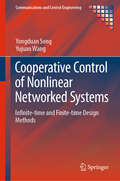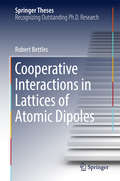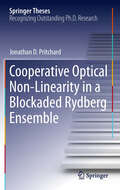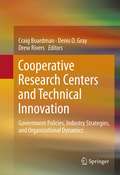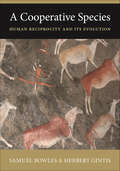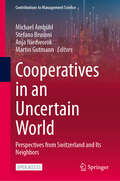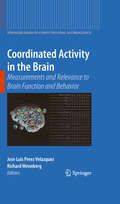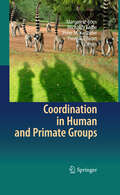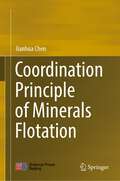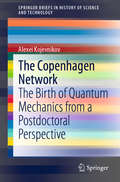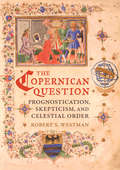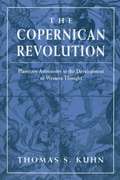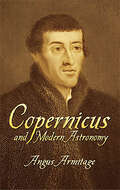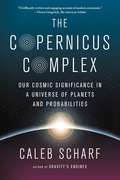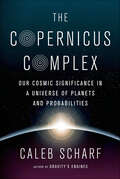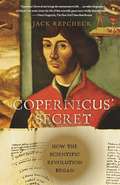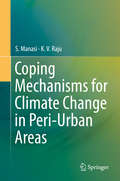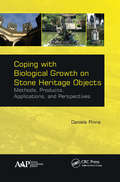- Table View
- List View
Cooperative Control of Multi-agent Systems: A Hybrid System Approach
by Guanglei Zhao Hailong Cui Changchun Hua Shuang LiuThis book focuses on stability analysis and control design approaches for multi-agent systems under network-induced constraints. A hybrid system approach is introduced to address the cooperative control problem of networked multi-agent systems, and several important topics such as asynchronous sampled data cooperative control, hybrid event-triggered cooperative control, and reset-based cooperative control are studied under the hybrid system framework. The special feature of this book is that a hybrid systems approach is proposed for the cooperative control of multi-agent systems, which is beneficial for relaxing the conservativeness of stability analysis and network parameter computation. Interested readers can learn a novel approach to cooperative control of multi-agent systems, and this book can benefit researchers, engineers, and graduate students in the fields of multi-robot cooperation, unmanned aerial vehicle formation, control engineering, etc.
Cooperative Control of Nonlinear Networked Systems: Infinite-time and Finite-time Design Methods (Communications and Control Engineering)
by Yongduan Song Yujuan WangCooperative Control of Nonlinear Networked Systems is concerned with the distributed cooperative control of multiple networked nonlinear systems in the presence of unknown non-parametric uncertainties and non-vanishing disturbances under certain communication conditions. It covers stability analysis tools and distributed control methods for analyzing and synthesizing nonlinear networked systems. The book presents various solutions to cooperative control problems of multiple networked nonlinear systems on graphs. The book includes various examples with segments of MATLAB® codes for readers to verify, validate, and replicate the results. The authors present a series of new control results for nonlinear networked systems subject to both non-parametric and non-vanishing uncertainties, including the cooperative uniformly ultimately bounded (CUUB) result, finite-time stability result, and finite-time cooperative uniformly ultimately bounded (FT-CUUB) result. With some mathematical tools, such as algebraic graph theory and certain aspects of matrix analysis theory introduced by the authors, the readers can obtain a deeper understanding of the roles of matrix operators as mathematical machinery for cooperative control design for multi-agent systems. Cooperative Control of Nonlinear Networked Systems is a valuable source of information for researchers and engineers in cooperative adaptive control, as its technical contents are presented with examples in full analytical and numerical detail, and graphically illustrated for easy-to-understand results. Scientists in research institutes and academics in universities working on nonlinear systems, adaptive control and distributed control will find the book of interest, as it contains multi-disciplinary problems and covers different areas of research.
Cooperative Interactions in Lattices of Atomic Dipoles (Springer Theses)
by Robert BettlesThis thesis reports the remarkable discovery that, by arranging the dipoles in an ordered array with particular spacings, it is possible to greatly enhance the cross-section and achieve a strong light-matter coupling (>98% of the incident light). It also discusses the broad background to cooperative behaviour in atomic ensembles, and analyses in detail effects in one- and two-dimensional atomic arrays. In general, when light interacts with matter it excites electric dipoles and since the nineteenth century it has been known that if the amplitude of these induced dipoles is sufficiently large, and their distance apart is on the scale of the wavelength of the light, then their mutual interaction significantly modifies the light-matter interaction. However, it was not known how to exploit this effect to modify the light-matter interaction in a desirable way, for example in order to enhance the optical cross-section.
Cooperative Optical Non-Linearity in a Blockaded Rydberg Ensemble (Springer Theses)
by Jonathan D. PritchardThis thesis describes the first demonstration of a cooperative optical non-linearity based on Rydberg excitation. Whereas in conventional non-linear optics the non-linearity arises directly from the interaction between light and matter, in a cooperative process it is mediated by dipole-dipole interactions between light-induced excitations. For excitation to high Rydberg states where the electron is only weakly bound, the dipole-dipole interactions are extremely large and long range, enabling an enormous enhancement of the non-linear effect. Consequently, cooperative non-linear optics using Rydberg excitations opens a new era for quantum optics enabling large single photon non-linearity to be accessible in free space for the first time. The thesis describes the theoretical underpinnings of the non- linear effect, the pioneering experimental results and implications for experiments in the single photon regime.
Cooperative Research Centers and Technical Innovation: Government Policies, Industry Strategies, and Organizational Dynamics
by Drew Rivers Denis O. Gray Craig BoardmanAt a time when scientific and technical innovation now requires a multitude of heterogeneous inputs and expertise from the public and private sectors alike, cooperative research centers (CRCs) have emerged as the predominant vehicle for cross-sector collaboration. In the U.S. alone, there are thousands of CRCs on university campuses, and agencies like the National Science Foundation, National Institutes of Health, Department of Defense, and more recently the Department of Energy fund CRCs to address some of the nation's most formidable challenges with science and technology, including cancer and other diseases, terrorism surveillance and the detection of weapons of mass destruction, and new energy technologies and smart energy grid development. Industry oftentimes participates in CRCs for access to knowledge, capacity development, and to mitigate risk. This volume includes research investigating CRCs from North America, Europe, Australia, and Asia to explore the dynamics of CRCs, including but not limited to resource allocation, structure, level of sponsorship, organization and membership, management and operations, objectives and goals, and in doing so identifies both differences and similarities across institutional and national contexts. The volume sheds light on the role of CRCs in promoting innovation, S&T policy, and economic development, and on the practical aspects of successful CRC management. Moreover, the works included in the volume consider the implications for the various stakeholder groups (firms, universities, researchers, students, policymakers) invested in CRCs.
A Cooperative Species: Human Reciprocity and Its Evolution
by Samuel Bowles Herbert GintisA fascinating look at the evolutionary origins of cooperationWhy do humans, uniquely among animals, cooperate in large numbers to advance projects for the common good? Contrary to the conventional wisdom in biology and economics, this generous and civic-minded behavior is widespread and cannot be explained simply by far-sighted self-interest or a desire to help close genealogical kin.In A Cooperative Species, Samuel Bowles and Herbert Gintis—pioneers in the new experimental and evolutionary science of human behavior—show that the central issue is not why selfish people act generously, but instead how genetic and cultural evolution has produced a species in which substantial numbers make sacrifices to uphold ethical norms and to help even total strangers.The authors describe how, for thousands of generations, cooperation with fellow group members has been essential to survival. Groups that created institutions to protect the civic-minded from exploitation by the selfish flourished and prevailed in conflicts with less cooperative groups. Key to this process was the evolution of social emotions such as shame and guilt, and our capacity to internalize social norms so that acting ethically became a personal goal rather than simply a prudent way to avoid punishment.Using experimental, archaeological, genetic, and ethnographic data to calibrate models of the coevolution of genes and culture as well as prehistoric warfare and other forms of group competition, A Cooperative Species provides a compelling and novel account of how humans came to be moral and cooperative.
Cooperatives in an Uncertain World: Perspectives from Switzerland and Its Neighbors (Contributions to Management Science)
by Stefano Brusoni Martin Gutmann Michael Ambühl Anja NiedworokThis book focuses on different aspects of cooperatives in Switzerland and its neighboring countries, and their contribution to meeting overarching societal challenges. It seeks to identify how cooperatives can tackle grand societal challenges and extends the body of research on cooperatives. The discussions are highlighted in the context of the UN’s Sustainable Development Goals. The respective chapters cover topics such as cooperatives in Switzerland (historical roots, current landscape, embeddedness in profit/nonprofit organizations, participatory governance and legal aspects), grand societal challenges and cooperatives, and the future with and of cooperatives. This is an open access book.
Coordinated Activity in the Brain: Measurements and Relevance to Brain Function and Behavior (Springer Series in Computational Neuroscience #2)
by Jose Luis Velazquez Richard WennbergIncreasing interest in the study of coordinated activity of brain cell ensembles reflects the current conceptualization of brain information processing and cognition. It is thought that cognitive processes involve not only serial stages of sensory signal processing, but also massive parallel information processing circuitries, and therefore it is the coordinated activity of neuronal networks of brains that give rise to cognition and consciousness in general. While the concepts and techniques to measure synchronization are relatively well characterized and developed in the mathematics and physics community, the measurement of coordinated activity derived from brain signals is not a trivial task, and is currently a subject of debate. Coordinated Activity in the Brain: Measurements and Relevance to Brain Function and Behavior addresses conceptual and methodological limitations, as well as advantages, in the assessment of cellular coordinated activity from neurophysiological recordings. The book offers a broad overview of the field for investigators working in a variety of disciplines (neuroscience, biophysics, mathematics, physics, neurology, neurosurgery, psychology, biomedical engineering, computer science/computational biology), and introduces future trends for understanding brain activity and its relation to cognition and pathologies. This work will be valuable to professional investigators and clinicians, graduate and post-graduate students in related fields of neuroscience and biophysics, and to anyone interested in signal analysis techniques for studying brain function.
Coordinated Science: Physical, Earth, and Space Sciences
by Ruta Demery Gary Freebury Robert Ritter Michael Smith John B. SouthardCoordinated Science is an innovative core curricula assembled from three proven inquiry-based programs. It is supported by the National Science Foundation and was developed by leading educators and scientists. Unit 1, Physics, was developed by the American Association of Physics Teachers and the American Institute of Physics.
Coordinated Science for the 21st Century: An Integrated, Project-Based Approach
by Arthur Elsenkraft Ruta Demery Gary Freebury Robert Ritter Michael Smith John B. SouthardCoordinated Science for the 21st Century is an innovative core curricula assembled from four proven inquiry-based programs. This book comprises four units, viz., 1. Active Physics, 2. Active Chemistry, 3. Active Biology, and 4. Earthcomm. Each unit of this course has been designed and built on the National Science Education Standards. Each utilizes the same instructional model and the same inquiry-based approach.
Coordination Chemistry: Basics and Current Trends
by Birgit WeberThe Chemistry of Complex Compounds is ideally prepared in this textbook for undergraduate chemistry students, providing both an easy and comprehensive introduction to the subject, which is relevant to examinations. It is based on proven lecture notes and assumes no basic knowledge. In addition to basic questions such as "what are complexes" and "what are organometallic compounds", the common bonding models are presented and the colour and stability of coordination compounds are explained, among other things. Other chapters cover redox reactions in complexes, the metal-metal bond, molecular magnetism, supramolecular chemistry, and bioinorganic chemistry. As a conclusion, the book gives an outlook into current research areas and trends in coordination chemistry, so that students of higher semesters and PhD students will also benefit from reading it. This includes the luminescence of complexes and selected examples of reactions catalyzed by complexes. Birgit Weber is a professor of inorganic chemistry at the University of Bayreuth. Her research focuses on coordination chemistry and ligand design for multifunctional switchable complexes.
Coordination in Human and Primate Groups
by Thomas Ellwart Peter M. Kappeler Margarete Boos Michaela KolbeCoordination in Human and Primate Groups presents one of the first collections of the different approaches and methods used to assess coordination processes in groups. Written by psychologists and primatologists, the book represents a broad range of coordination research fields such as social psychology, work and organizational psychology, medicine, primatology, and behavioural ecology. It is designed for researchers and practitioners interested in understanding the behavioural aspects of group coordination.
Coordination of Complex Sociotechnical Systems: Self-organisation of Knowledge in MoK (Artificial Intelligence: Foundations, Theory, and Algorithms)
by Stefano MarianiThe book discusses the main issues of coordination in complex sociotechnical systems, covering distributed, self-organising, and pervasive systems. A chemistry-inspired model of coordination, a situated architecture and coordination language, and a cognitive model of interaction are the ingredients of the Molecules of Knowledge (MoK) model for self-organisation of knowledge presented in this book. The MoK technology is discussed, along with some case studies in the fields of collaborative systems, academic research, and citizen journalism. The target audience includes researchers and practitioners in the field of complex software systems engineering. The book is also appropriate for graduate and late undergraduate students in computer science and engineering.
Coordination Principle of Minerals Flotation
by Jianhua ChenThe advent of flotation, with selective interaction of reagents with minerals at its core, has greatly advanced the development of modern mining. Ever since, there has been continuous researched into the mechanism of mineral-reagent interactions, in an effort to design and develop more effective reagents. A unique perspective from coordination is presented to illustrate the principles of reagent molecules interacting with metal ions on mineral surface. For the first time, the influence is unveiled of mineral crystal structures and surrounding atoms on metal ion properties and further on mineral-reagent interactions. The introduction of classical theories for modern chemistry, including orbital structure, electron spin and orbital symmetry matching, into flotation is realized. Researchers, engineers and graduate students among others in the field of mineral processing may gain new insight into flotation and the development of novel reagents.
The Copenhagen Network: The Birth of Quantum Mechanics from a Postdoctoral Perspective (SpringerBriefs in History of Science and Technology)
by Alexei KojevnikovThis book is a historical analysis of the quantum mechanical revolution and the emergence of a new discipline from the perspective, not of a professor, but of a recent or actual Ph.D. student just embarking on an uncertain academic career in economically hard times. Quantum mechanics exploded on to the intellectual scene between 1925 and 1927, with more than 200 publications across the world, the majority of them authored by young scientists under the age of 30, graduate students or postdoctoral fellows. The resulting theory was a collective product that no single authority could claim, but it had a major geographical nod – the Copenhagen Institute of Theoretical Physics – where most of the informal, pre-published exchange of ideas occurred and where every participant of the new community aspired to visit. A rare combination of circumstances and resources – political, diplomatic, financial, and intellectual – allowed Niels Bohr to establish this “Mecca” of quantum theory outside of traditional and more powerful centres of science. Transitory international postdoctoral fellows, rather than established professors, developed a culture of research that became the source of major innovations in the field. Temporary assistantships, postdoctoral positions, and their equivalents were the chief mode of existence for young academics during the period of economic crisis and post-WWI international tensions. Insecure career trajectories and unpredictable moves through non-stable temporary positions contributed to their general outlook and interpretations of the emerging theory of quantum mechanics. This book is part of a four-volume collection addressing the beginnings of quantum physics research at the major European centres of Göttingen, Copenhagen, Berlin, and Munich; these works emerged from an expansive study on the quantum revolution as a major transformation of physical knowledge undertaken by the Max Planck Institute for the History of Science and the Fritz Haber Institute (2006–2012).
The Copernican Question: Prognostication, Skepticism, and Celestial Order
by Robert S. WestmanIn 1543, Nicolaus Copernicus publicly defended his hypothesis that the earth is a planet and the sun a body resting near the center of a finite universe. But why did Copernicus make this bold proposal? And why did it matter? The Copernican Question reframes this pivotal moment in the history of science, centering the story on a conflict over the credibility of astrology that erupted in Italy just as Copernicus arrived in 1496. Copernicus engendered enormous resistance when he sought to protect astrology by reconstituting its astronomical foundations. Robert S. Westman shows that efforts to answer the astrological skeptics became a crucial unifying theme of the early modern scientific movement. His interpretation of this "long sixteenth century," from the 1490s to the 1610s, offers a new framework for understanding the great transformations in natural philosophy in the century that followed.
The Copernican Revolution: Planetary Astronomy In The Development Of Western Thought
by Thomas KuhnThe Copernican Revolution: Planetary Astronomy In The Development Of Western Thought
The Copernican Revolution: Planetary Astronomy in the Development of Western Thought
by Thomas S. KuhnFor scientist and layman alike this book provides vivid evidence that the Copernican Revolution has by no means lost its significance today. Few episodes in the development of scientific theory show so clearly how the solution to a highly technical problem can alter our basic thought processes and attitudes. Understanding the processes which underlay the Revolution gives us a perspective, in this scientific age, from which to evaluate our own beliefs more intelligently. With a constant keen awareness of the inseparable mixture of its technical, philosophical, and humanistic elements, Thomas S. Kuhn displays the full scope of the Copernican Revolution as simultaneously an episode in the internal development of astronomy, a critical turning point in the evolution of scientific thought, and a crisis in Western man s concept of his relation to the universe and to God. The book begins with a description of the first scientific cosmology developed by the Greeks. Mr. Kuhn thus prepares the way for a continuing analysis of the relation between theory and observation and belief. He describes the many functions astronomical, scientific, and nonscientific of the Greek concept of the universe, concentrating especially on the religious implications. He then treats the intellectual, social, and economic developments which nurtured Copernicus break with traditional astronomy. Although many of these developments, including scholastic criticism of Aristotle s theory of motion and the Renaissance revival of Neoplatonism, lie entirely outside of astronomy, they increased the flexibility of the astronomer s imagination. That new flexibility is apparent in the work of Copernicus, whose De Revolutionibus Orbium Coelestium (On the Revolutions of the Heavenly Spheres) is discussed in detail both for its own significance and as a representative scientific innovation. With a final analysis of Copernicus life work its reception and its contribution to a new scientific concept of the universe Mr. Kuhn illuminates both the researches that finally made the heliocentric arrangement work, and the achievements in physics and metaphysics that made the planetary earth an integral part of Newtonian science. These are the developments that once again provided man with a coherent and self-consistent conception of the universe and of his own place in it. This is a book for any reader interested in the evolution of ideas and, in particular, in the curious interplay of hypothesis and experiment which is the essence of modern science. Says James Bryant Conant in his Foreword: Professor Kuhn s handling of the subject merits attention, for he points the way to the road which must be followed if science is to be assimilated into the culture of our times.
Copernicus and Modern Astronomy
by Angus ArmitageMasterly and authoritative, this book by the foremost scholar on the 16th-century astronomer provides lucid accounts of the development and progress of the Copernican theory as well as a fascinating portrait of the man who clarified the basis for modern cosmology. 41 figures. 6 halftones.
The Copernicus Complex: Our Cosmic Significance in a Universe of Planets and Probabilities
by Caleb ScharfNicolaus Copernicus dared to go against the establishment by proposing that Earth rotates around the Sun. Having demoted Earth from its unique position in the cosmos to one of mediocrity, Copernicus set in motion a revolution in scientific thought. <P><P>This perspective has influenced our thinking for centuries. However, recent evidence challenges the Copernican Principle, hinting that we do in fact live in a special place, at a special time, as the product of a chain of unlikely events. But can we be significant if the Sun is still just one of a billion trillion stars in the observable universe? <P><P>And what if our universe is just one of a multitude of others-a single slice of an infinity of parallel realities? In The Copernicus Complex, the renowned astrophysicist Caleb Scharf takes us on a scientific adventure, from tiny microbes within the Earth to distant exoplanets, probability theory, and beyond, arguing that there is a solution to this contradiction, a third way of viewing our place in the cosmos, if we weigh the evidence properly. <P><P>As Scharf explains, we do occupy an unusual time in a 14-billion-year-old universe, in a somewhat unusual type of solar system surrounded by an ocean of unimaginable planetary diversity: hot Jupiters with orbits of less than a day, planet-size rocks spinning around dead stars, and a wealth of alien super-Earths. Yet life here is built from the most common chemistry in the universe, and we are a snapshot taken from billions of years of biological evolution. <P><P>Bringing us to the cutting edge of scientific discovery, Scharf shows how the answers to fundamental questions of existence will come from embracing the peculiarity of our circumstance without denying the Copernican vision. <P><P> With characteristic verve, Scharf uses the latest scientific findings to reconsider where we stand in the balance between cosmic significance and mediocrity, order and chaos. <P><P> Presenting a compelling and bold view of our true status,The Copernicus Complex proposes a way forward in the ultimate quest: determining life's abundance, not just across this universe but across all realities.
The Copernicus Complex: Our Cosmic Significance in a Universe of Planets and Probabilities
by Caleb ScharfLonglisted for the 2015 PEN/E.O. Wilson Literary Science Writing AwardShort-listed for Physics World's Book of the YearThe Sunday Times (UK) Best Science Book of 2014A Publishers Weekly Top 10 Science Book of Fall 2014An NBC News Top Science and Tech Book of 2014A Politics & Prose 2014 Staff PickIn the sixteenth century, Nicolaus Copernicus dared to go against the establishment by proposing that Earth rotates around the Sun. Having demoted Earth from its unique position in the cosmos to one of mediocrity, Copernicus set in motion a revolution in scientific thought. This perspective has influenced our thinking for centuries. However, recent evidence challenges the Copernican Principle, hinting that we do in fact live in a special place, at a special time, as the product of a chain of unlikely events. But can we be significant if the Sun is still just one of a billion trillion stars in the observable universe? And what if our universe is just one of a multitude of others-a single slice of an infinity of parallel realities?In The Copernicus Complex, the renowned astrophysicist Caleb Scharf takes us on a scientific adventure, from tiny microbes within the Earth to distant exoplanets, probability theory, and beyond, arguing that there is a solution to this contradiction, a third way of viewing our place in the cosmos, if we weigh the evidence properly. As Scharf explains, we do occupy an unusual time in a 14-billion-year-old universe, in a somewhat unusual type of solar system surrounded by an ocean of unimaginable planetary diversity: hot Jupiters with orbits of less than a day, planet-size rocks spinning around dead stars, and a wealth of alien super-Earths. Yet life here is built from the most common chemistry in the universe, and we are a snapshot taken from billions of years of biological evolution. Bringing us to the cutting edge of scientific discovery, Scharf shows how the answers to fundamental questions of existence will come from embracing the peculiarity of our circumstance without denying the Copernican vision.With characteristic verve, Scharf uses the latest scientific findings to reconsider where we stand in the balance between cosmic significance and mediocrity, order and chaos. Presenting a compelling and bold view of our true status, The Copernicus Complex proposes a way forward in the ultimate quest: determining life's abundance, not just across this universe but across all realities.
Copernicus' Secret: How the Scientific Revolution Began
by Jack RepcheckThe surprising, little-known story of the scientific revolution that almost didn't happen: how cleric and scientific genius Nicolaus Copernicus's work revolutionized astronomy and altered our understanding of our place in the world.Nicolaus Copernicus gave the world perhaps the most important scientific insight of the modern age, the theory that the earth and the other planets revolve around the sun. He was also the first to proclaim that the earth rotates on its axis once every twenty-four hours. His theory was truly radical: during his lifetime nearly everyone believed that a perfectly still earth rested in the middle of the cosmos, where all the heavenly bodies revolved around it. One of the transcendent geniuses of the early Renaissance, Copernicus was also a flawed and conflicted person. A cleric who lived during the tumultuous years of the early Reformation, he may have been sympathetic to the teachings of the Lutherans. Although he had taken a vow of celibacy, he kept at least one mistress. Supremely confident intellectually, he hesitated to disseminate his work among other scholars. It fact, he kept his astronomical work a secret, revealing it to only a few intimates, and the manuscript containing his revolutionary theory, which he refined for at least twenty years, remained "hidden among my things." It is unlikely that Copernicus' masterwork would ever have been published if not for a young mathematics professor named Georg Joachim Rheticus. He had heard of Copernicus' ideas, and with his imagination on fire he journeyed hundreds of miles to a land where, as a Lutheran, he was forbidden to travel. Rheticus' meeting with Copernicus in a small cathedral town in northern Poland proved to be one of the most important encounters in history. Copernicus' Secret recreates the life and world of the scientific genius whose work revolutionized astronomy and tells the fascinating story behind the dawn of the scientific age.
Coping Mechanisms for Climate Change in Peri-Urban Areas
by S. Manasi K. V. RajuThis book discusses the dynamics and resource management qualities of the peri-urban interface to address climate change consequences, focusing on the peri-urban region of the global city of Bengalaru. In 5 chapters, the authors document the unique challenges experienced in peri-urban areas, including soil-water vegetation dynamics, local and regional impacts on water bodies (surface and groundwater), food production issues, and the inhibited adaptive capacity of local communities. The book also provides knowledge on implementations of environmental management by local institutions, government interventions that have acted as catalysts in promoting community based adaptation strategies, and the physical, social and economic aspects of rural-urban dynamics. The book not only adds to the scarce existing literature on peri-urban contexts, but also addresses the role of culture in protecting ecological landscapes and how traditions play an important role in coping with climate change. Furthermore, the authors expand on these climate change coping mechanisms in peri-urban areas, taking into account local cultural factors and interesting governance interventions in the context of health. The book will be of interest to planners, policy makers, and students and researchers engaged in rural-urban dynamics and climate change adaptation.
Coping with Biological Growth on Stone Heritage Objects: Methods, Products, Applications, and Perspectives
by Daniela PinnaCoping with Biological Growth on Stone Heritage Objects: Methods, Products, Applications, and Perspectives offers hands-on guidance for addressing the specific challenges involved in conserving historical monuments, sculptures, archaeological sites, and caves that have been attacked and colonized by micro- and macroorganisms. The volume provides many case studies of removal of biological growth with practical advice for making the right choices. It presents detailed and updated information related to biocides and to alternative substances, features that will be valuable to dealing with these challenges. The author’s goal is to provide access to information and offer the conceptual framework needed to understand complex issues, so that the reader can comprehend the nature of conservation problems and formulate her/his own views. From bacteria to plants, biological agents pose serious risks to the preservation of cultural heritage. In an effort to save heritage objects, buildings, and sites, conservators’ activities aim to arrest, mitigate, and prevent the damages caused by bacteria, algae, fungi, lichens, plants, and birds. Although much has been learned about these problems, information is scattered across meeting proceedings and assorted journals that often are not available to restorers and conservators. This book fills the gap by providing a comprehensive selection and examination of international papers published in the last fifteen years, focusing on the appropriate methods, techniques, and products that are useful for the prevention and removal of micro- and macroorganisms that grow on artificial and natural stone works of art, including wall paintings. Results on new substances with antimicrobic properties and alternative methods for the control of biological growth are presented as well. The book also emphasize issues on bioreceptivity of stones and the factors influencing biological growth and includes an outline of the various organisms able to develop on stones, a discussion on the bioprotection of stones by biofilms and lichens, a review of the main analytical techniques, and a section on bioremediation. This volume will be a valuable reference for cultural heritage conservators and restorers, scientists, and heritage-site staff involved in conservation and maintenance of buildings, archaeological sites, parks, and caves.
Coping with Choices to Die
by C. G. PradoThis book examines the reactions of the friends and family of those who elect to die due to terminal illness. These surviving spouses, partners, relatives, and friends, in addition to coping with the death of a loved one, must deal with the loved one's decision to die, thus severing the relationship. C. G. Prado examines how reactions to elective death are affected by cultural influences and beliefs, particularly those related to life, death, and the possibility of an afterlife. Understanding the role of these cultural influences on the grieving processes of survivors is a crucial step in allowing them to accept both intellectually and emotionally the finality of elective death and to deal with the decision of their loved one.

